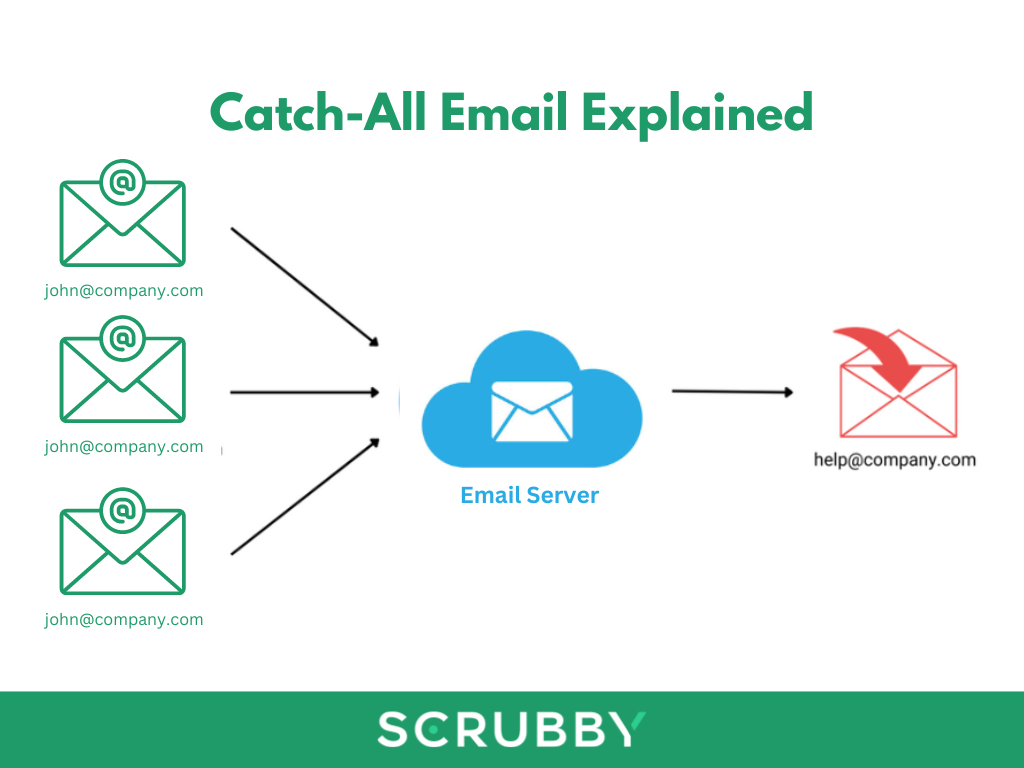Catch-all emails, also known as accept-all emails, are addresses configured to receive any email sent to a domain, regardless of whether the specific mailbox exists. While they might seem convenient for capturing all incoming messages, they can wreak havoc on your email marketing efforts. Why? Because catch-all addresses often result in higher bounce rates, lower engagement, and tarnished sender reputation..
How does catch-all emails work?
The operational principle of catch-all email addresses is both straightforward and efficient. Enabled within a catch-all domain, this functionality (also referred to as accept-all email) ensures that any legitimate emails sent to an incorrect or invalid email address within the catch-all domain are not discarded.
Here’s a breakdown of how it functions: Suppose someone mistakenly sends an email intended for support@yourdomain.com to contact@yourdomain.com.
The catch-all email system intervenes to ensure this email doesn’t vanish into oblivion. Instead, it intercepts and redirects it to the correct destination, such as your primary inbox. This feature is exceptionally valuable in preventing message loss due to minor typing errors.
Catch-all emails function as guardians for your inbox. Here’s a real-world scenario:
Imagine a customer intending to inquire about a product, but erroneously types ‘saels@yourdomain.com’ instead of ‘sales@yourdomain.com’.
No issue!
The catch-all email springs into action to ensure the message still reaches its intended recipient and receives a response.
Alternatively, suppose an important update is dispatched to an outdated email address that one of your team members no longer uses.
Once again, the catch-all email comes to the rescue, intercepting that email to ensure you remain informed of critical information.
Leveraging catch-all emails can revolutionize your email communication, facilitating seamless and efficient exchanges, particularly in business or organizational settings.

Why Catch-all Emails Matter?
Understanding catch-all emails begins with recognizing their significance in the email ecosystem. Unlike traditional email addresses associated with specific users or departments, catch-all addresses are configured to accept messages sent to any address at a given domain. While this setup might seem convenient, it poses several challenges for email marketers:
Inflated Subscriber Counts: Catch-all addresses inflate your subscriber counts, giving a false impression of your email list’s size and engagement level.
Higher Bounce Rates: Messages sent to catch-all addresses often bounce, leading to higher bounce rates and potential damage to your sender reputation.
Risk of Deliverability Issues: With catch-all addresses, there’s no guarantee that your emails will reach their intended recipients, jeopardizing deliverability and engagement metrics.
Why Validate Catch-All Emails?
When it comes to invalid and risky email types, email validation is the solution. It helps email marketers differentiate real contacts from spam traps, catch-alls, and other harmful address types.
Validating catch-all emails is essential for several reasons:
- Improved Deliverability: By identifying and removing invalid catch-all addresses from your list, you enhance the deliverability of your emails to genuine recipients.
- Reduced Bounce Rates: Eliminate the risk of bounced emails caused by undeliverable catch-all addresses, ensuring that your messages reach their intended audience.
- Enhanced Sender Reputation: Maintaining a clean email list boosts your sender reputation, which is vital for avoiding spam filters and achieving better inbox placement.
The Impact of catch-all emails on Email Marketing Campaigns
The presence of catch-all emails can disrupt your email marketing efforts in multiple ways:
- Poor Engagement: Messages sent to catch-all addresses rarely result in engagement, as they often end up in abandoned or unused mailboxes.
- Lower Open Rates: Since catch-all addresses typically receive a barrage of emails, yours might get lost in the clutter, leading to lower open rates.
- Reduced Conversion Rates: With fewer emails reaching genuine recipients, your conversion rates may suffer, impacting the overall success of your campaigns.
Empower Your Email Marketing Strategy with Scrubby
Fortunately, there’s a solution to the catch-all conundrum: Scrubby’s advanced email validation tool. By leveraging Scrubby’s robust features, you can:
Identify Catch-All Addresses: Scrubby’s sophisticated algorithms detect and flag catch-all domains and addresses within your email list.
Verify Domain Authenticity: Ensure the legitimacy of domains associated with catch-all addresses, minimizing the risk of sending emails to invalid or non-existent domains.
Enhance List Hygiene: By removing catch-all addresses and other invalid entries, Scrubby helps you maintain a clean and accurate email list, maximizing deliverability and engagement.
Bulk Validation: Whether you have a small list or a massive database, Scrubby offers bulk validation capabilities, allowing you to clean your entire email list quickly and efficiently.
Don’t let catch-all emails undermine the success of your email marketing campaigns. Equip yourself with the knowledge and tools needed to navigate the catch-all conundrum effectively. With Scrubby by your side, you can validate your email list with confidence, knowing that your messages will reach genuine recipients and drive meaningful results.
Sign up for Scrubby today and take control of your email marketing success!